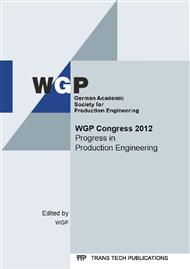[1]
Kopp, Gundolf; Beeh, Elmar: MAGNESIUM MACHT´S MÖGLICH - Super Light CarLeichtbau durch Multi-Material-Design mit integrierten Funktionen,. In: DLR - Nachrichten, Edition121, 2008, p.28 – 31.
Google Scholar
[2]
Zittel, R.: A Historical Review of High Speed Metal Forming,. Proceedings of 4th international conference on high speed forming, 2010, Columbus, pp.2-15.
Google Scholar
[3]
Shribman, V.: Magnetic Pulse Welding for Dissimilar and Similar Materials,. Proceedings of 3rd international conference on high speed forming, 2008, Dortmund, pp.13-22.
Google Scholar
[4]
Stiemer, M.; Unger, J.; Blum, H.; Svendsen, B.: Fast Algorithms for the Simulation of Electromagnetic Metal Forming,. Proceedings of 3rd international conference on high speed forming, 2008, Dortmund, pp.129-140.
Google Scholar
[5]
Bartels, G.; Schätzing, W.; Scheibe, H. -P.; Leone, M.: Simulation Models of the Electromagnetic Forming Process,. 2nd Euro-Asian Pulsed Power Conference, 2008, Vilnius, pp.1128-1129.
Google Scholar
[6]
Schätzing, W.; Scheibe, H. -P.; Wollenberg, G.: Berechnung des magnetischen Druckes bei der Magnetumformung". Tagungsband zum Kolloquium "Elektromagnetische Umformung, 2001, pp.33-38.
Google Scholar
[7]
Uhlmann, E.; Ziefle, A.: Lösungsansätze zur Darstellung des impulsmagnetischen Schweißprozesses mittels gekoppelter FEM-Simulation,. Proceedings of Berliner Runde, 2009, pp.13-22.
Google Scholar
[8]
Haiping, Y.U.; Chufeng, L.I.; Jianghua, D.E.N.G.: Sequential coupling simulation for electromagnetic-mechanical tube compression by finite element analyse,. Journal of Material Processing Technology, 2008, Vol. 209, pp.707-713.
DOI: 10.1016/j.jmatprotec.2008.02.061
Google Scholar
[9]
Haiping, Y.U.; Chufeng, L.I.: Effects of current frequency on electromagnetic tube compression,. Journal of Material Processing Technology, 2009, Vol. 209, pp.1053-1059.
DOI: 10.1016/j.jmatprotec.2008.03.011
Google Scholar
[10]
Bartels, G.; Schätzing, W.; Scheibe, H. -P.; Leone, M.: Models for Electromagnetic Metal Forming,. Proceedings of the 3rd International Conference on High Speed Forming, Dortmund, 2008, pp.121-128.
Google Scholar
[11]
Demir, O.K.; Psyk, V.; Tekkaya, A.E.: Simulation of tube wrinkling in electromagnetic compression,. Prod. Eng. Res. Devel., 2010, Vol. 4, pp.421-426.
DOI: 10.1007/s11740-010-0243-4
Google Scholar
[12]
Askeland, D.R.: Materialwissenschaften, Spektrum Verlag, Berlin, (1996).
Google Scholar
[13]
Bach, F.W.; Behrens, B.A.; Rodmann, M.; Roßberg, A.; Vogt, O.; Huinink, T.: Werkstoff- und Verfahrenstechnische Entwicklung von wirk-medienbasierten Umformprozessen für Magnesiumbleche,. In: Final report DFG Schwerpunktprogramm SPP 1098 - Bericht aus der Fertigungstechnik, 2006, p.115.
Google Scholar
[14]
Doege, E.: Umformverhalten von Magnesiumblechen,. In: Neuere Entwicklungen in der Blechumformung, International Conference. Frankfurt a. M.: MATINFO Werkstoff-Informationsgesellschaft, (2000), p.387 – 410.
Google Scholar
[15]
Pircher, H.; Weber, M.; Kawalla, R.: Magnesiumbleche für den Karosseriebau,. In: SFU, Sächsische Fachtagung Umformtechnik, Proceedings 9, p.221 – 231.
Google Scholar
[16]
Viehweger, B.; Richter, G.; Düring, M.; Karabet, A.; Sviridov, A.; Hartmann, H.; Richter. U.: Hydromechanisches Tiefziehen und Hochdruckumformung als Verfahren zur Herstellung komplexer Bauteile aus Magnesiumblechen des Typs AZ31B-0, Materialwissenschaften und Werkstofftechnik, Edition 35, Book 7, Weinheim: Wiley-VCH Verlag GmbH & Co. KGaA, (2004).
DOI: 10.1002/mawe.200400763
Google Scholar
[17]
Viehweger, B.; Richter, G.; Karabet, A.: Tiefziehen von Blechen der Mg-Legierung AZ31, hergestellt aus stranggegossenem Ausgangsmaterial,. In: Metall - Internationale Fachzeitschrift für Metallurgie, Edition 59, Book 4, (2005), pp.207-212.
Google Scholar
[18]
Droeder, K. G.: Untersuchungen zum Umformen von Feinblechen aus Magnesiumknetlegierungen. Ph.D., University Hannover, (1999).
Google Scholar
[19]
El-Magd, E.; Abouridouane, M.: Einfluss der Umformgeschwindigkeit und -temperatur auf das Umformvermögen metallischer Werkstoffe unter Druckbelastung (Teilprojekt 1) und Zugbelastung (Teilprojekt 2),. In: Final report DFG SPP 1074 - Ergebnisse aus 48 Forschungsprojekten, 1999 - (2005).
DOI: 10.3139/146.030729
Google Scholar
[20]
Ulacia, I., Salisbury, C.P., Hurtado, I., Worswick, M.J.: Tensile characterization and constitutive modeling of AZ31B magnesium alloy sheet over wide range of strain rates and temperatures. In: Journal of Materials and Processing, 2011, pp.830-839.
DOI: 10.1016/j.jmatprotec.2010.09.010
Google Scholar
[21]
Schäfer, R.; Pasquale, P.: Electromagnetic pulse forming technology. Keys for allocating the industrial market segment,. Proceedings of 4th international conference on high speed forming, 2010, Columbus, pp.16-25.
Google Scholar
[22]
Masumoto, I.; Tamaki, K. & Kojima, M.: Electromagnetic Welding of Aluminum tube to Aluminum or Dissimilar Metal Cores,. Transactions of the japan Welding Society, 1985, 14 - 20.
Google Scholar
[23]
T. Aizawa, M. Kashani, K. Okagawa, Application of magnetic pulse welding for aluminium alloys and spcc steel shet joints, Welding Research, 86, 2007, pp.119-124.
Google Scholar
[24]
S.D. Kore, P.P. Date, S.V. Kulkarni, Electromagnetic impact welding of aluminium to stainless steel sheets, Journal of Materials Processing Technology, 208, pp.486-493, (2008).
DOI: 10.1016/j.jmatprotec.2008.01.039
Google Scholar
[25]
H. Kreye, M. Hammerschmidt, U. Granz, C. -P. Woidneck, Über den Bindemechanismus beim Explosivschweißen, Schweißen und Schneiden, 37, pp.297-302, (1985).
Google Scholar


